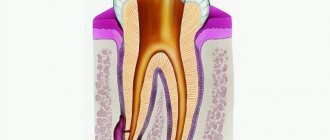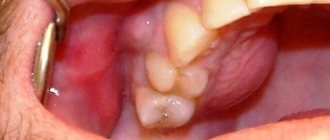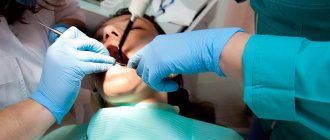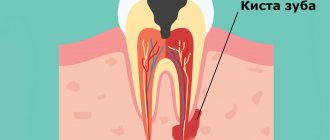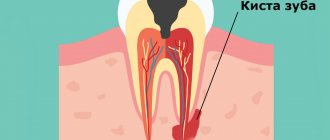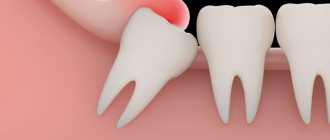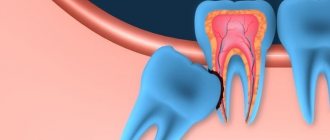- Questions and answers
- Stock
- Reviews
- Causes
- Types of cysts
- Symptoms
- Treatment
| Prices | Causes | Types of cysts | Symptoms | Treatment |
A dental cyst is a pathological neoplasm that occurs as a result of the body’s defensive reaction to infection or injury. A cyst occurs when pathogenic microorganisms that cause inflammation enter the jaw bone tissue through the root canal. Gradually, the cells involved in the disease process die, forming a cavity in the bone tissue. To prevent the spread of the process, our body forms a capsule with dense walls around the necrosis zone.
The resulting neoplasm contains inflammatory fluid, dead cells, decay products and bacteria. Sizes range from a few millimeters to several centimeters. Small ones (less than 5 mm in diameter) are called granulomas. Granuloma, cystogranuloma and cyst are stages of the inflammatory process in the bone tissue of the jaw. As long as it is small, there will be no manifestations. The number of microbes in it continues to grow, but since this happens under the control of the immune system, the process develops unnoticed. Immune cells are sent to the cyst through the blood vessels that feed the bone tissue. This is how the body tries to cope with the problem. But, if the immune system weakens, the disease enters the acute phase.
The development of the disease can lead to serious consequences. An increase in size threatens a fracture (especially of the lower) jaw, loss of teeth involved in the inflammatory process, and degeneration into a malignant tumor. Exacerbation of the disease leads to the development of periostitis, purulent abscess or even osteomyelitis. If at this stage the patient does not receive qualified medical care, sepsis may begin. This is an extremely serious condition, characterized by infection entering the blood and subsequently spreading throughout the body.
Types of cysts
Root cyst
Develops from granuloma as a continuation of pulpal necrosis (death of pulp tissue) and as a result of periapical inflammation. It is located in the apical (apical) third of the tooth root and sometimes has a transverse orientation due to additional canals, the initial paths for the spread of pulpous necrosis.
Root cysts are radiolucent capsules with well-defined boundaries. They can vary greatly in size from 2-3 mm to 2-3 cm. In the absence of secondary inflammation, the roots develop asymptomatically. Even the largest neoplasms do not displace teeth or expand bone tissue.
Once diagnosed, treatment requires eliminating the underlying cause. The most common treatment for pulp necrosis is endodontic treatment. If it is unsuccessful, a decision is made on surgical curettage or enucleation.
Residual
Remains after removal of the pathology. It can form in the granuloma left after tooth extraction or around the left apex of the root.
The residual cyst is clearly visible on x-ray. Its dimensions range from a few millimeters to several centimeters.
Follicular cyst on the gum
A cyst in the gum develops from a follicular sac that encloses each unerupted tooth. This is a capsule clearly visible on an x-ray, most often surrounding the crown of an unerupted tooth. May cause extensive tooth damage. It has a rapid growth rate, can move to adjacent teeth and lead to expansion of the cortical plate.
Clinically, a follicular cyst always occurs in the area where the enamel meets the cementum of the tooth (the place of attachment of the follicle). Due to its growth, adjacent teeth may tilt, and in rare cases, resorption (destruction) of tooth roots occurs. Unerupted teeth can also become displaced due to aggressive growth. If a follicular neoplasm has been identified, its treatment may include surgical curettage (curettage).
Eruption cyst
This is a fluid-filled follicular sac that usually occurs during teething. It covers the erupting tooth and often contains blood. Outwardly it looks like pronounced swelling of soft tissues of a bluish color (due to the presence of blood). Most often it occurs due to slow tooth eruption and can rupture spontaneously. However, in some cases where it is found, treatment may include surgical resection to help the tooth erupt faster.
Primordial (keratocyst)
Develops from the tooth germ as a result of degeneration of the stellate reticulum during tooth development before the onset of calcification of its tissues. Keratocysts can arise from any developing tooth germ, but most often they are localized in the area of premolars and the third molar of the mandible.
Clinically very prone to relapse. If the patient is diagnosed, treatment consists of careful curettage and close follow-up to ensure early detection of recurrence of pathology.
Lateral periodontal
The exact reasons for their occurrence are not fully known. They are rarely large. They are clearly visible on an x-ray and are most often closely associated with the lateral surface of the tooth root. Typically, teeth associated with these cysts have normal pulp. When a lateral periodontal neoplasm (cyst) is detected on the root of a tooth, treatment consists of surgical curettage without compromising the integrity of the tooth. It is important that the removed tissue is sent for histological analysis to rule out more serious pathologies such as early adamantinoma.
Calcifying odontogenic
Their etiology is also completely unknown. They can be found in any area of the supporting surface of the jaws, most often in the lower part. Morphologically they are quite diverse. Clearly visible on x-ray and may contain various opacities depending on the degree of calcification of the tumor. Once diagnosed, treatment consists of surgical curettage or resection.
Cyst on the root of a tooth
This species grows in the alveolar area and can appear in any area of the gum. There are no symptoms except for tingling when eating or touching. Pain appears in later stages of development. A cyst on the root of a tooth is divided into 3 types:
- Peri-root - appears in the upper part of the root.
- Interroot – formed between the roots.
- Radical - appears near the root canal and over time can cause the growth of a malignant tumor of the jaw (if not properly treated).
Symptoms of a dental cyst
Most often it is formed as a result of traumatic injury or infection, for example, due to poor-quality root canal filling in the sinus of the tooth. Often this pathology occurs against the background of frequent sinusitis. Treatment should begin with a visit to the dentist and an x-ray. At an early stage it does not manifest itself in any way. The primary symptom is discomfort when chewing solid food.
As it develops, a protrusion of bone tissue or a fistula on the gum in the area of the apex of the damaged tooth may be observed.
When the disease worsens, patients complain of acute pain. The reason for the transition of the disease to the acute phase may be a weakened immune system, relapses of chronic diseases, hypothermia, infectious diseases, or the use of certain medications, such as immunosuppressants (drugs that artificially suppress the immune system). An exacerbation may be accompanied by the following symptoms:
- swelling of the face in the area of the damaged area;
- increased body temperature;
- general malaise;
- enlargement and tenderness of the submandibular cervical lymph nodes;
- pain in the area of the damaged tooth, intensifying when chewing.
You should not ignore these symptoms if you want to undergo treatment without tooth extraction. When the first signs of illness appear, you should immediately seek help from a dentist.
Treatment of a cyst without tooth extraction
The success of treatment directly depends on how early it was detected. Therefore, dentists recommend that patients undergo regular preventive examinations and seek help at the first signs of illness. More recently, therapy necessarily involved tooth extraction. Of course, this approach did not suit either the doctors or especially their patients. Today, dentists' methods have changed significantly, and it is possible to get rid of a cyst without losing the beauty of your smile.
Treatment of the cyst can be surgical or conservative. The choice of therapy method depends on: the type, age of the patient, personal wishes and is determined for each patient.
Surgery
Most often, a cystectomy procedure is performed to surgically remove a tumor. It involves removing the cyst and damaged root tip. The advantage of this method is its high efficiency. Its disadvantages include the fact that cystectomy is a rather complex operation, and not every surgeon decides to perform it.
A more complex method is hemisection. This operation is performed when one of the roots is completely destroyed. During surgery, the doctor removes the disease-causing capsule, damaged root and part of the tooth crown. The defect resulting from surgical resection is eliminated using composite materials or a crown.
Much depends on at what stage the capsule was discovered. Treatment can be accompanied by tooth extraction only if it is entirely located in the capsule of the cyst or its tissues are almost completely destroyed.
Post-treatment care
The duration of recovery depends on the treatment method used. If the cyst is treated without surgery, the patient may experience minor discomfort in the first days. The tooth may become slightly loose for about 2 weeks.
Rehabilitation after surgery takes longer and is more difficult. In the first 3-7 days after removal of the cyst, the tooth hurts, swelling of the gums and cheeks is observed. Painful symptoms are relieved with painkillers from the NSAID group (Nimesil, Ibuprofen, Ketorolac). In the first days, the sutured wound may bleed a little, turning the saliva pink. Stitches are usually removed within 7-10 days. In the first 2-8 weeks, sensitivity to cold and sweets is observed, and for 3-4 weeks the teeth become loose.
Medical recommendations
- To reduce swelling, apply cold compresses to the cheek for 10-15 minutes several times a day (especially in the first 6 hours).
- Brushing your teeth should be replaced by rinsing with antiseptic solutions. In the first 8-10 days, tampons with antiseptics, for example, chlorhexidine, must be applied to the sutured gum. Complete teeth cleaning is allowed after 2 weeks.
- Avoid hot foods for the first 2-3 days. Until the wound heals, try to chew on the healthy side. Give preference to soft foods (porridge, purees).
- An increase in temperature to 37.5ºC and a slight sore throat are a normal reaction to surgery. Antibiotics are prescribed after cyst removal to relieve inflammation and prevent the spread of infection. It is useless to take such drugs on your own in the hope of getting rid of the tumor without dental care. The antibacterial drug is selected by the attending dentist. The course of treatment is 7-10 days.
- It is strictly forbidden to heat the cyst. Until complete healing, avoid overheating in the sun, refuse to visit the sauna/bath and heavy physical activity.
It is necessary to immediately contact a dental clinic if, after removal of the cyst, bleeding occurs, the temperature persists for more than 3 days or rises sharply, swelling of the cheek and gums increases, and pus comes from the wound.
Treatment of a dental cyst requires a dentist to be highly qualified and have sufficient experience. At the first signs of pathology, make an appointment at the First Family Clinic of St. Petersburg.
Conservative treatment
This type of therapy allows you to be cured without surgery. In this case, an incision is not required to gain access to the tumor. At the initial stage of treatment, the dentist drills out and cleans out the affected root canal. The apex of the tooth root connects to the cyst, so once the root canal is opened, the contents flow out. After cleaning and disinfecting the root canal, the doctor introduces antibiotics and substances into the cavity that destroy its capsule.
After this, the doctor fills the resulting cavity with a special paste that will help restore bone tissue. The hole is then filled. If after 6 months the cyst is not detected on an x-ray, the treatment can be considered successful. This method helps in about 75% of cases.
An innovative treatment method without surgery
is depophoresis. It helps eliminate infection in all root canals without drilling them. The dentist exposes the mouth of the canal and inserts an electrode into it. Another electrode is pressed against the surface of the cheek, which produces a weak current discharge. Together with the discharge, copper-calcium hydroxide is passed through the root canal, which penetrates into all hard-to-reach areas, destroying all bacteria, microorganisms and dead cells.
After three sessions of depophoresis, the damaged tooth is filled and its crown is restored. Regardless of what type of tumor was detected, treatment with depophoresis allows you to get rid of it in almost 100% of cases.
Removal of a dental cyst. Historically significant and modern methods of surgery for removing dental cysts
Initially, the most common method of treating cysts was their removal. For this purpose, 2 fundamentally different methods were used: cystotomy and cystectomy.
Cystotomy (or the PARCH-I method) has historical significance in the development and establishment of medicine. Today this method is practically not used, but previously it was indispensable for removing large cysts. To avoid complications and its severe consequences, a wide channel was created between the cyst cavity and the vestibule of the oral cavity by suturing the edges of the cyst shell with the oral mucosa.
Cystectomy (or PARCH-II method) involves complete excision/removal of the cyst. This surgical intervention is often simultaneously accompanied by the removal of the root apex, the source of the formation of the cyst containing infected apical deltas. Today this method is the most popular.
The main goal of cystectomy is complete sanitation of the cyst cavity, which is not possible without resection of the root apex. The fact is that the root pulp in its apical third has an apical delta with an unclear structure and very fine branching of the canals, even in single-rooted teeth. If such canals can be cleaned during tooth treatment, then during retreatment this is almost impossible, especially considering the narrowness of the lateral deltas. Removing the root apex, in addition, allows you to most effectively clean the cyst cavity behind the root. This is especially true for teeth 12 and 22, which have a more curved root system. The operation is carried out as follows: using a small incision on the gum, the surgeon very carefully reaches the surface of the bone located above the cystic cavity, removes the wall with a trephine or bur, making sure that the neighboring teeth are not damaged, and then removes the cyst shell and performs a resection of the root apex . Next, sanitation of the cystic cavity is carried out and its subsequent revision for residual cyst particles. After this, in some cases, retrograde filling is performed. The final step in the operation to remove cystic formations is filling the resulting cavity with osteoplastic material and suturing the wound.
In the case of the formation of a large cyst, amputation of the apex of the tooth root can be performed, or half of the tooth and damaged root can be removed (hemessection), and in the case of an interradicular cyst, this can be done by corono-radicular separation.
Cost of treating a cyst under a tooth
The price of dental services for the treatment of cysts in our clinic is about 8,500 rubles. and depends on the following factors:
- type;
- complexity of the disease;
- method of treatment (surgical or therapeutic);
- use of complex equipment;
- expenses for surgical or dental supplies;
| Service | Price |
| Consultation | |
| Orthopantomogram OPTG of the jaw | from 1,100 ₽ |
| Cystectomy | 5 300 ₽ |
| Hemisection | 3 300 ₽ |
Look at the detailed price list for dental treatment at NovaDent dentistry in Moscow and the pain-free region.
If you have been diagnosed with a dental cyst, it should be treated by a qualified dentist. Many patients do not fully understand the danger of this disease. Photos of the cyst can be found on the Internet. From them it can be understood that this can cause the destruction of large areas of bone tissue. And this, in turn, poses a risk of jaw fracture and tooth loss.
Expert of the article you are reading: Svetlana Viktorovna Derevyakina Chief physician, doctor of the highest qualification category, therapist, periodontist, leading specialist of the NovaDent network
28 years
Clinical experience
Petrovsko-Razumovskaya
Verkhniye Likhobory
st. Dubninskaya, 27, building 1
+7
Free consultation with this specialist


